Office organization involves grouping similar activities in an organization together which results in the establishment of various departments and sections and assigning responsibilities, duties and authority among its personnel. This ensures an organization objectives are attained.
When an organization has been divided into departments and sections and responsibilities and duties have been allocated to the available staff, an organization’s organization structure is thus formed. Therefore, an organization structure indicates who in the organization has authority, who is responsible to whom and for what at any level.
ORGANISATION CHARTS
An organization chart is a diagrammatic illustration of an organization structure.
Factors to consider when designing an organization chart
- The various departments and sections should be portrayed .
- The charts should show the lines of command so that every subordinate knows his or her superior.
- The number of levels of management should be kept to a minimum otherwise communication both upwards and downwards suffers.
- The span of control should be portrayed, that is, the number of persons under the control of the superior.
- Lines of communication both upwards and downwards should be indicated since the principle of delegation of authority should be encouraged.
TYPES OF ORGANISATION CHARTS
- Vertical Organization Chart
The chart lies in a vertical position with the lines of command and authority shown from top to bottom. The senior executives are at the top of the chart and successive levels of management depicted below that.
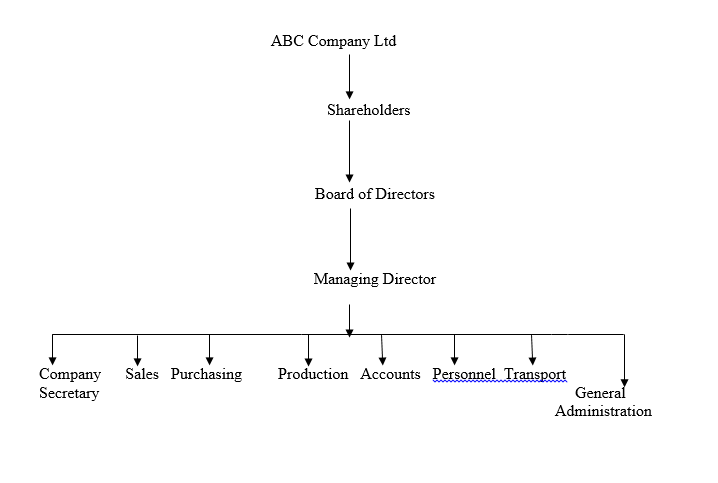
2. Horizontal Organization Chart
The organization chart lies horizontally with the lines of command and authority proceeding horizontally from left to right. The top levels at the left and each successive levels extending to the right.
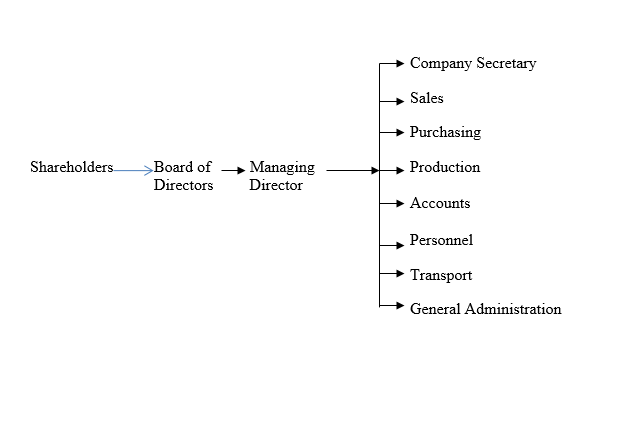
3. Circular Organization Chart
It shows the top positions at the centre of a series of concentric circles from where authority extends in all directions with the outermost circles showing the operative workers.
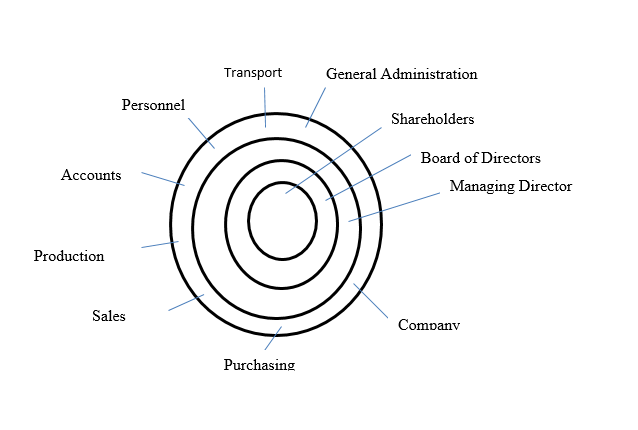
Advantages of Organization Chart
- The whole organization structure can be seen at a glance enabling all members of staff to be aware of how each section, department and the whole organization is structured.
- Sphere of responsibility and authority are clearly shown.
- Lines of communication are easily seen.
- The span of control of each supervisor or manager can be seen.
- It can be used to show the new members of staff how the organization is structured.
- It assists the outsiders learn to how the organization operates.
- It is easier to understand and review the structure when it is analyzed graphically.
Disadvantages of Organization Chart
- It becomes outdated due to changes of positions.
- It is expensive to prepare the charts.
- Space provided is not enough to fill all the details required.
- Sometime it may give a misleading picture if the interpretation is too narrow.
- Usually it shows formal relationships and fails to show informal relationships within an organization.
- By showing status it dilutes team spirit.
- Although it shows lines of authority, it fails to show how much authority and how far ones responsibility extends.
- It shows a static state of affairs and does not show flexibility which ought to exist in a dynamic organization.
WORK PLAN
A secretary can have planning units with the largest unit being a year, scaled down to a month, then to a week and a day being the shortest unit, so that the yearly unit content is spread over the 12 months, monthly unit content over four weeks and the weekly unit content spread over the five days.
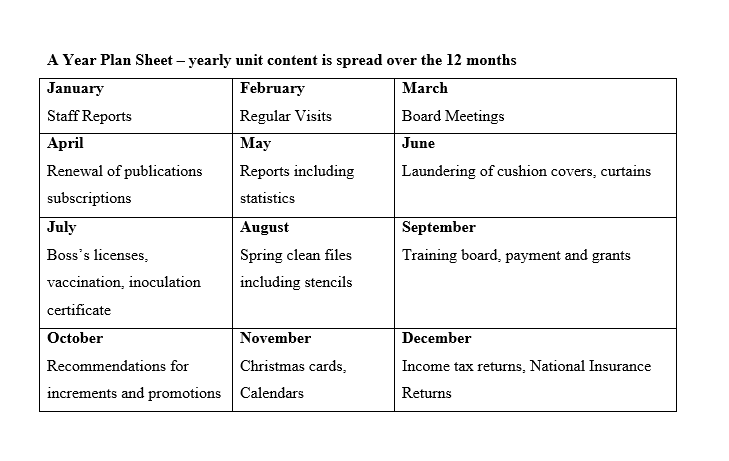
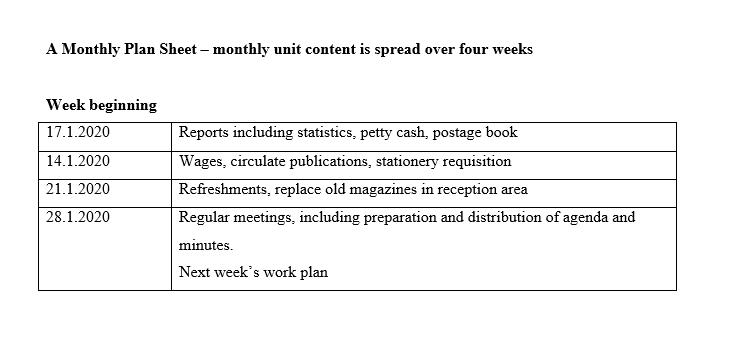

Planning units therefore can be visualized as years, half-years, months, weeks or days.
The largest unit contains the outline plan which has to be broken down into smaller units which become increasingly more detailed as each individual section and sub-section is considered as a planning unit
For example:
Your boss has just had his revaccination.
- This will have to be renewed in three years’ time. Note it immediately in the appropriate month of the year-plan sheet for three years ahead.
- Later when the detailed planning is done, it will be noted in the appropriate week of the month-plan sheet, depending on your boss’s workload and other commitments. Finally it will be allocated to a particular day again depending on workload and the availability of an appointment. It is important to look ahead all the time so that items can be dealt with at the most suitable time.
- The content of each unit will depend to some extent on:
- The organization in which you work and your boss’s job
- Also the type of work and the length of time taken to carry out different aspects of the same job. For example it may take longer to produce the accounts for a Board meeting than to produce an engineering report.
PLANNING AIDS/OFFICE AIDS/MEMORY DEVICES
- A desk diary
It is used to indicate the daily activities.
It is used as a reminder of:
- Work deadlines
- Appointments and meetings
- Files to be followed up
- Staff absences – holidays, etc
- Social engagements
- A computerized desk diary planner
It is kept on a computer so that the entries can be seen on a VDU and a print out made when required. An entry is made by keying in the date, time and brief details of the item and if an appointment is cancelled or changed to another time or date it can be removed from the memory and re-entered on another date if necessary.
- Year planners
These are large plastic calendars where the events/business activities of that year are entered in the appropriate date boxes. It is displayed on the wall so that all years activities can be seen at a glance and also to plan engagements methodically on one single sheet. Special events or significant dates can be highlighted using self-adhesive coloured signals/special or bright colours.
- Tickler System or Tickler File
Has file folders labeled January to December. In each file we have divider cards or sheets of stiff paper labeled 1-31 to divide the days of the month. A tickle file helps to remind you of activities that have to be done or enable you to make a follow-up of an activity to ensure matters are not forgotten and are dealt with a the correct time.
For example:
- Pay bills
- Follow up delegated actions, orders, requests
- Purchase or write your anniversary, birthday cards, medical and legal appointment, maintenance of car lawn care, warranty for products, travel documents – travel tickets, hotel confirmation and supporting documents
- A tickler file system is kept near you within an arm’s reach and ideally visible where you can access the system quickly and one should go through the file every morning.
- Desktop Organizers
Used to get a workers desk organized and be able to find your office supplies, paper work, important files and everything you need. It is an organization tool to enable easy location of items required e.g. stacked trays, shelf units, loose-leaf binders, desk pads, desk trays and sorters, drawer organizers, file sorters.
The following aids to tidiness are worth remembering
- Keep stationery either in a rack or in a drawer
- Use four filing trays – for incoming mail, outgoing mail, work in hand and papers released for filing
- Keep reference books on a shelf close at hand with bookends to support them.
- Have a locking drawer allocated for petty cash and postage books and other such records
- Keep a memo, pad and pencil by the telephone
- Keep office sundries (paper, clips etc) in the top right-hand desk drawer
- Have a special place on the desk for stapling machine, perforator, rubber, stamp stand etc and put each article back on its right place after use.
REVISION QUESTIONS
- Outline three ways that a diary is of use to a secretary. (3 marks)
- State three aids that a secretary may use to enhance tidiness at her work desk. (3 marks)
- State two uses of the tickler system. (3 marks)
- Highlight three types of information that could be obtained from an organization chart. (3 marks)
- Identify four memory aids in an office and explain the use of each to a secretary. (8 marks)
